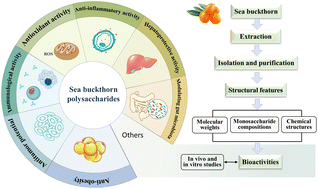Medicinal and edible polysaccharides from ancient plants: extraction, isolation, purification, structure, biological activity and market trends of sea buckthorn polysaccharides
Abstract
Sea buckthorn (Hippophae L.), a well-known medicinal and edible plant, is known as the “king of VC”. Due to its excellent medicinal and nutritional value, it has been developed into a variety of functional products. Sea buckthorn polysaccharides (SPs), one of the important and representative active components, have attracted the attention of researchers in the fields of health food and medicine because of their potential beneficial effects on human health. Recently, SPs have shown various biological activities in in vitro and in vivo studies, such as anti-obesity, immunomodulatory, anti-tumor, antioxidant, anti-inflammatory, anti-fatigue, and hepatoprotective activities. This review provides a comprehensive and systematic summary of the extraction and purification methods, structural characterization, biological activity, and market trends of SPs to provide a theoretical basis for their therapeutic potential and sanitarian functions. A future scope is needed to further explore the medicinal and nutritional value of SPs and incorporate them in functional food products.

- This article is part of the themed collection: Food & Function Review Articles 2024


 Please wait while we load your content...
Please wait while we load your content...